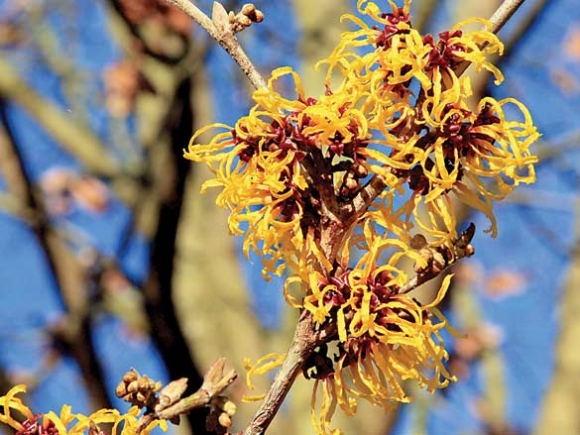Witch-hazel has adapted as a late flowering plant

Editor’s note: this article first appeared in a November 2003 edition of The Smoky Mountain News.
If you take a walk along a woodland edge within the next few weeks, there’s every chance you’ll discover witch-hazel in full bloom. It sometimes flowers by early September and will persist into late December or early January during warm winters. But from early October into early November is the time to catch witch-hazel in its prime.
Witch-hazel is renowned as a utilitarian plant, especially as an astringent or as the forked branch of choice for those dowsing for water. But before we consider its utilitarian possibilities, let’s first take a look at its natural history.
Flowers are designed to attract pollinators. Somehow witch-hazel has “discovered” that a late flowering period provides a niche in which the competition with other plants for certain pollinators is at a minimum.
In The Natural History of Wild Shrubs and Vines (1989), Donald Stokes observes that, “A question for which I have not been able to find an answer is, ‘Who pollinates the flowers?’ It blooms when very few insects are out collecting food. I have watched the flowers when they are in bloom and the only visitors I have seen are ants.”
I don’t know the answer to that question either, but you can easily observe that during warm intervals (when insects would be out and about) witch-hazel’s yellow tassels are unfurled, thereby allowing access to the floral cup. During cold snaps, the tassels curl tightly over the cup to protect the plant’s sexual parts.
Related Items
Note that last year’s fruits are ripening just as this year’s flowers appear. These grayish-brown, hairy capsules are tiny cannons that eject their black seeds with such force they can land up to 30 feet away from the parent shrub or tree. If you hear a mysterious crackling in the leaf litter, it’s probably the result of a witch hazel seed bombardment.
What’s in a name? One source suggests that witch-hazel’s seed propulsion tactics “suggested witchcraft to those who first observed the phenomenon.” Another source suggests that the plant’s leaves often display cone-shaped insect galls that resemble “the hat of a witch.” And yet another source observes that “the name refers not to magic and witchcraft but to an old English word meaning ‘to bend.’” Take your pick.
I’m inclined to go along with the last suggestion since witch-hazel has traditionally been utilized in water-witchery; that is, the locating of water by the use of a forked branch that bends over its objective. In A Natural History of Trees (1950), Donald Culross Peattie provides some details: “You took a forked branch (of witch-hazel), one whose points grew north and south so that they had the influence of the sun at its rising and setting, and you carried it with a point in each hand, the stem pointing forward. Any downward tug of the stem was caused by the flow of hidden water.”
Witch-hazel leaf extract is widely used today as an astringent for toning skin. Virtually all of the facial cleansers in your local pharmacy will feature this extract. Herbal Medicine Past and Present (vol. 2, 1989) by John K. Crellin and Jane Philpot, provides the following background:
“The basis of witch-hazel’s reputation has long rested on the astringency due to hydrolysable tannins. Distilled witch-hazel contains no tannins but a small amount of volatile oil. Alcohol is usually added, which provides a sense of astringency when applied to the skin; this, plus a characteristically pleasant taste and odor, probably accounts for the considerable reputation of distilled witch-hazel for bruises and cuts … Recent concern has been expressed over the presence of a safrole (a carcinogen), but this is irrelevant because of the small quantity present. Furthermore, preparations of witch-hazel are employed externally, including for hemorrhoids.
(George Ellison is a naturalist and writer. He can be reached at This email address is being protected from spambots. You need JavaScript enabled to view it..)









